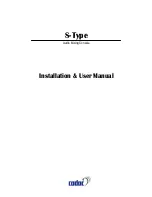
M7CL
Quick Start Guide Part 1
2
Table of Contents
A quick guide to the M7CL hardware versions
............3
M7CL
related
hardware
............4
Preparing the console before you start
............5
Scene
000
or
Initialization?
............5
Getting sound from M7CL-48/32 in 10 easy steps
............6
Getting sound from M7CL-48ES and SB168-ES in 2 easy stages
............7
The
Basics; ............8
Accessing
the
channel
......8
Changing the channel parameters. HA popup; +48V.
......9
Channel parameter pop-ups. From Overview
.....10
Channel parameter pop-ups. From Single Channel View
.....11
Sends on fader; an easy way of mixing Mix Groups/auxiliaries.
(Monitor,
Effect
or
Matrix
Sends) .....12
Channel parameter pop-ups. The ATT/HPF/EQ pop-up in detail
...........13
Naming
Channels ...........14
Patching, routing channels. How to change a patch
...........15
Patching, routing channels. The default Patch, Scene 000
...........16
Mix outputs; selecting aux/sub group, pre/post fade,
send
point
etc
...........17
Matrix outputs; routing, features ...........18
Trouble
shooting
ideas ...........19
M7CL Quick Start Guides.
The M7CL Quick Start Guide is in multiple parts. It is available as a download from www.yamahaproaudio.com in
the “Self Training” area. Also available is the revised M7CL Short-cuts and Tips List.
Part 1
is an introduction to the M7CL and its variations and goes on to describe the basic operations of the con-
sole to the level of a similar featured analogue console.
Part 2
introduces the extra features provided only by digital consoles; the internal effects rack package and the
basic use of scenes to store and recall parameters.
Part 3
looks at scene memory use in more detail and the connection of the PC based software for remote control
and setup; Studio Manager and M7CL Editor.
M7CL-48ES users may also wish to look at Yamaha’s EtherSound Setup Guide. This explains the basic principals of
designing an EtherSound network.



































